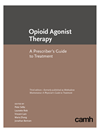Text adapted in 2023 from "Opioid Use and Opioid Use Disorders" in The Primary Care Addiction Toolkit. Available online only.
Opioid use disorder features a compulsive pattern of opioid use leading to significant impairment in occupational, social and interpersonal functioning (American Psychiatric Association, 2013). The diagnosis requires that the person meet at least two of the 11 DSM-5 criteria within a 12-month period:*
- Opioid use in larger amounts or over longer period of time than intended
- Unable to cut down or control opioid use
- Great deal of time is spent to obtain, use and recover from opioid use
- Cravings
- Recurrent opioid use resulting in failure to fulfill major role obligations at work, school or home
- Continued use despite social or interpersonal problems
- Important occupational, social or recreational activities are given up
- Recurrent opioid use in physically hazardous situations
- Continued use despite physical or psychological problems caused by opioid use
- Tolerance
- Withdrawal.
These criteria can be grouped into four categories: impaired control (criteria 1–4), social impairment (criteria 5–7), risky use (criteria 8–9) and physical dependence (criteria 10–11).
* DSM-5 criteria reprinted with permission from Diagnostic and Statistical Manual of Mental Disorders (5th ed.), American Psychiatric Association, 2013, Arlington, VA © 2013 American Psychiatric Association.
Physical dependence and addiction
Many patients who take opioids daily are physically dependent. This is a state of physical adaptation manifested by tolerance to opioids and withdrawal if the person suddenly stops taking the opioid.
Physical dependence is not the same as having an opioid use disorder. Most patients who take prescribed opioids do not become addicted to them, even with long-term use. People are addicted to a drug when they find its psychoactive effects so reinforcing that they have trouble controlling their use of the drug, and their compulsive drug use creates social, financial or psychological difficulties (American Society of Addiction Medicine, n.d.).
Patients at high risk for opioid use disorder
Many factors contribute to the development of an opioid use disorder. The strongest predictor is current or past addiction to opioids or other substances, such as alcohol, cocaine, benzodiazepines or cannabis (Fishbain et al., 2008; Fleming et al., 2008). Other risk factors include:
- younger age (under 40)
- male sex
- concurrent mental health problems, including personality disorders, somatoform disorders, anxiety disorders – particularly posttraumatic stress disorder – and mood disorders (Becker et al., 2008; Edlund et al., 2007; Klimas et al. 2019; Substance Abuse and Mental Health Services Administration, 2022; Wilsey et al., 2008)
- childhood trauma
- family history of addiction and mental health problems.


